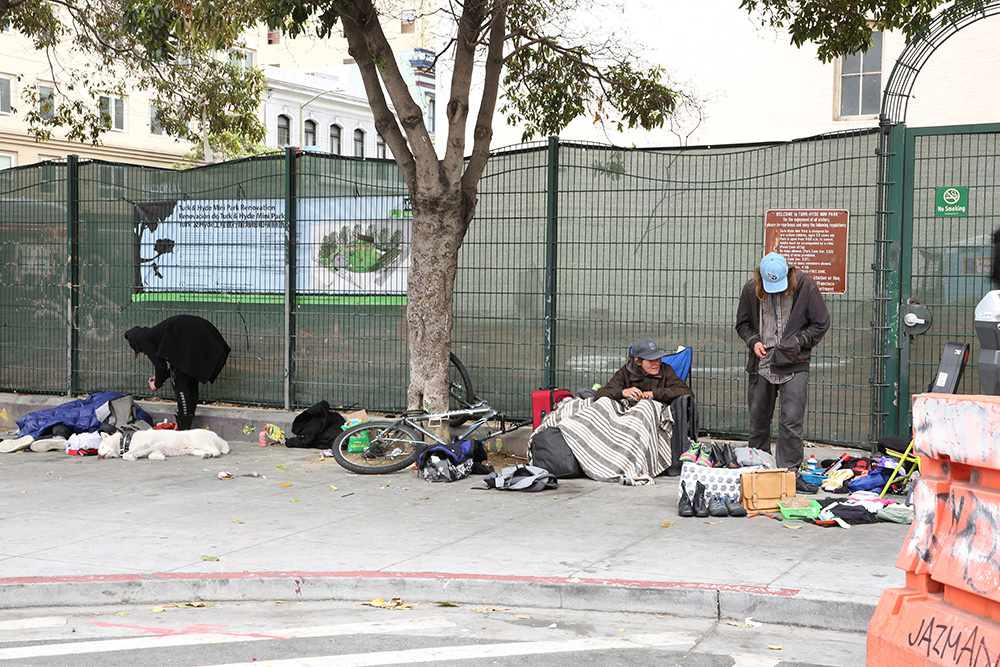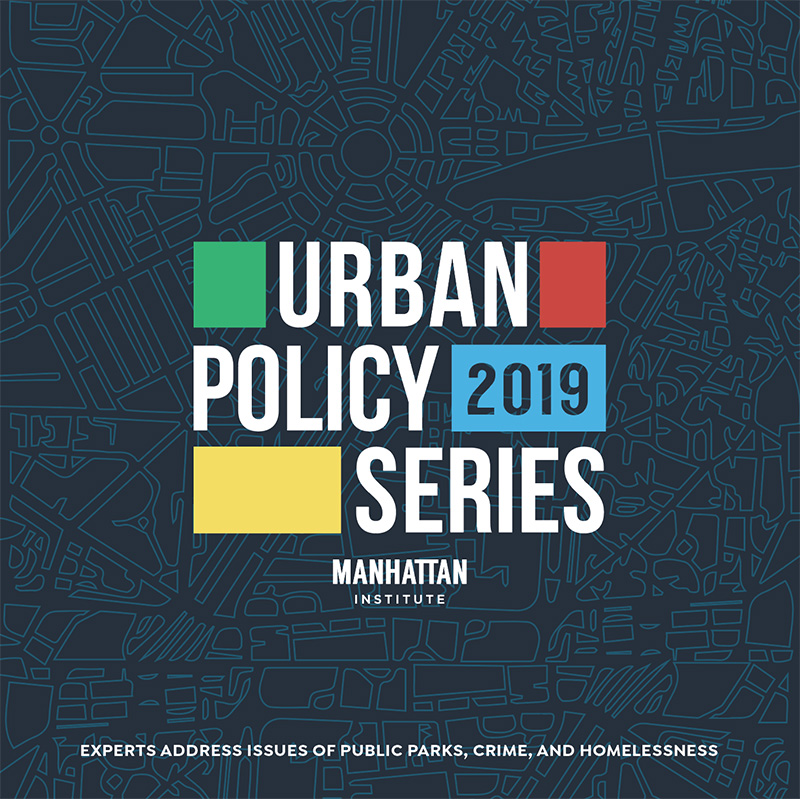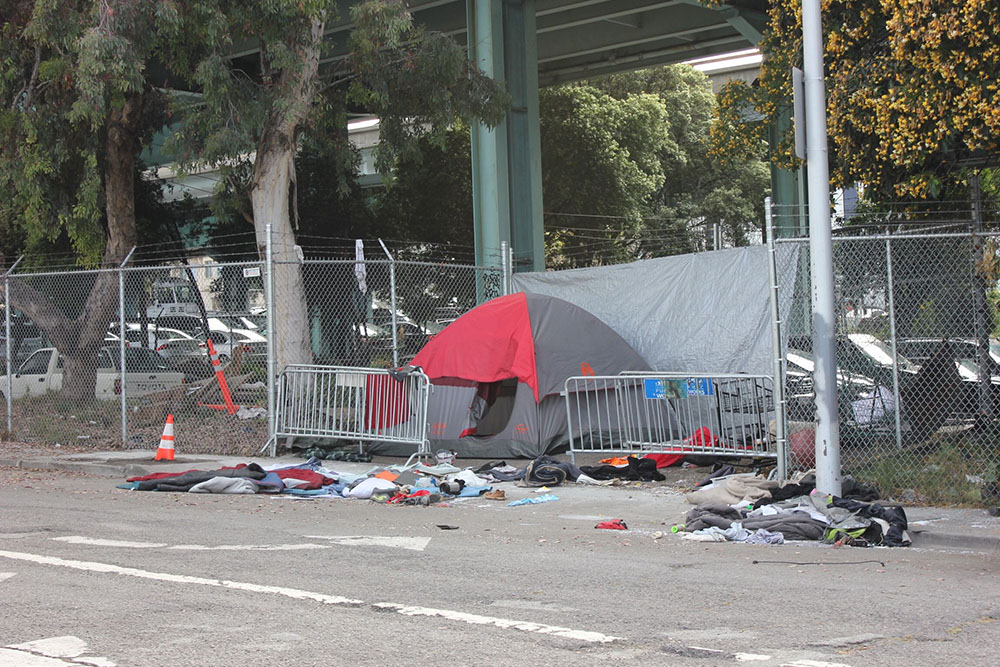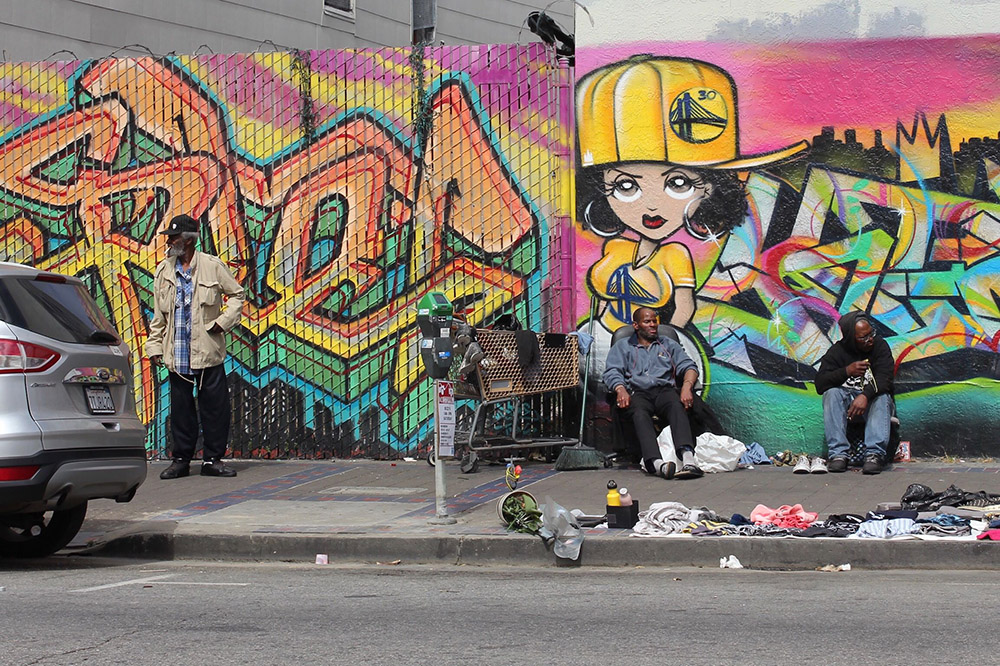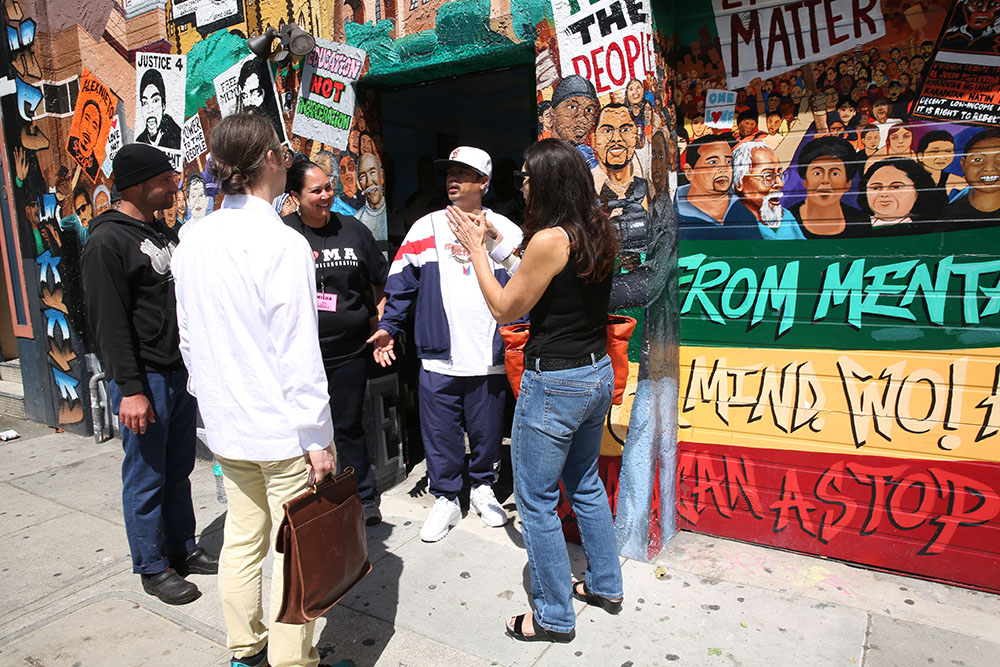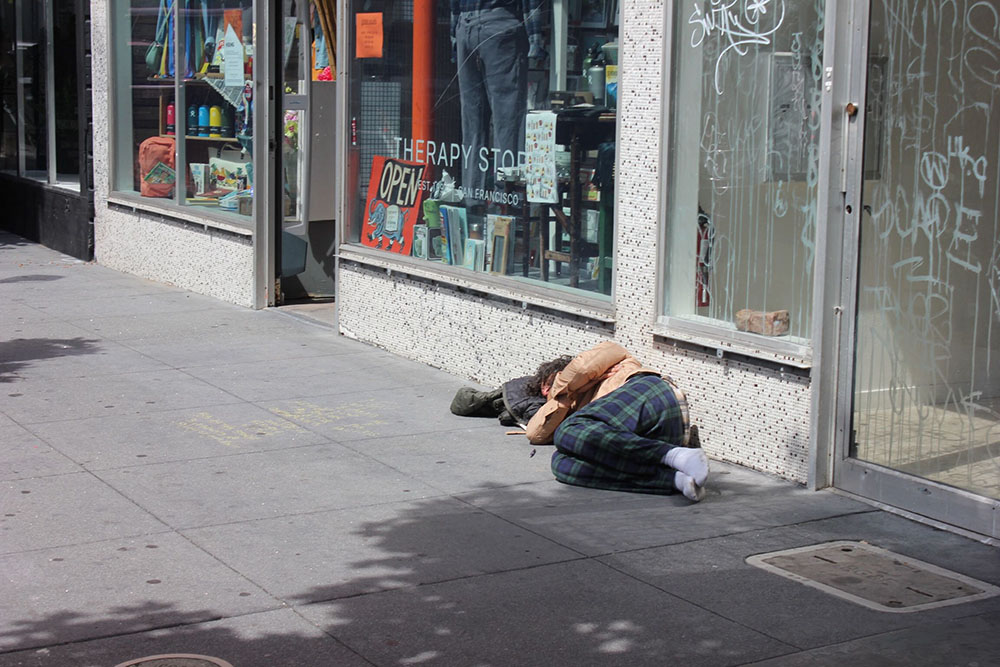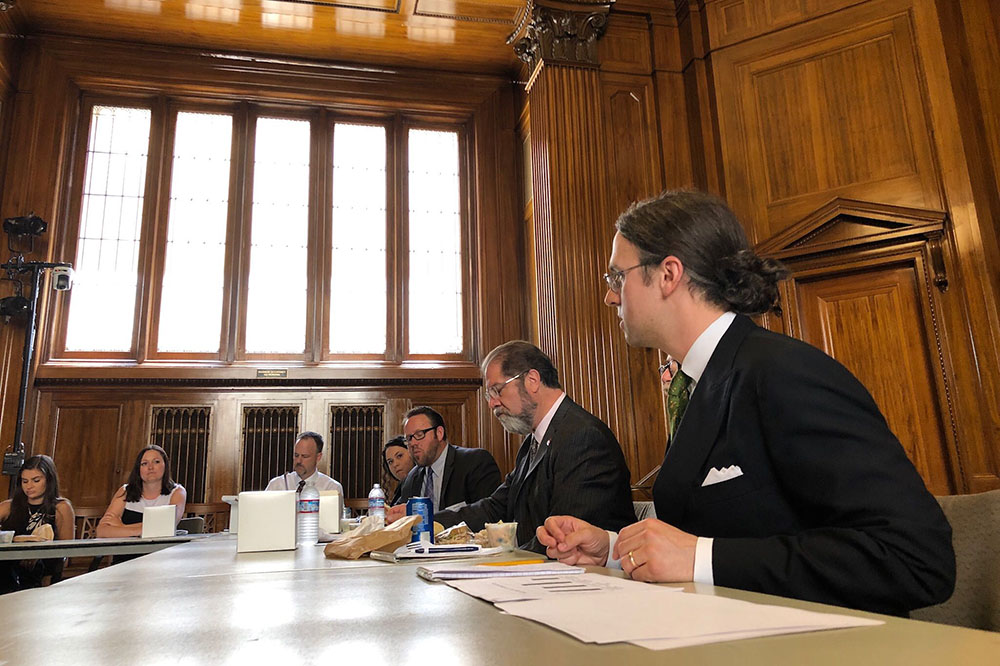Introduction
Editor's note: The following is the third article in the Urban Policy 2019 published by the Manhattan Institute.
Homelessness-related public disorder is one of the leading policy challenges in major U.S. cities. Widespread concern about homelessness has been registered in surveys of the public.[1] Almost daily, it seems, newspapers and government agencies are issuing reports about the many public health dangers now arising from the continued expansion of the unsheltered homeless.[2]
Most would agree that any policy response requires both social-welfare and law-enforcement dimensions. On the social-welfare front, several major cities have increased their spending on homeless services. In fiscal year 2019, New York spent more than $3 billion,[3] San Francisco about $360 million,[4] and Los Angeles city and county governments combined more than $600 million.[5] Spending has risen in all three jurisdictions, thanks to a combination of voter approvals for new taxes for homeless services[6] and healthy local economies. Between 2013 and 2018, the number of permanent supportive housing units in New York City, Los Angeles County, and San Francisco increased by 50%, 44%, and 62%, respectively.[7]
Cities have been more ambivalent about law enforcement. In the 1980s, when there was a concurrent rise in violent crime and homelessness, many thought the two were related. More recently, though, homelessness has continued to increase but murder and other serious offenses have declined, resulting in lower levels of support for using the criminal-justice system to address homelessness.
This chapter will discuss some common misconceptions about the law-enforcement response to homelessness, including the legality of regulating sleeping in public, panhandling, and civil commitment. It will conclude by laying out a list of principles to guide a law-enforcement response to homelessness.
Common Misconceptions About “Criminalization”
The debate around a law-enforcement response to homelessness is often framed as a debate over the “criminalization of homelessness.” However, that characterization, which has been used not only by homeless advocates[8] but also the Trump administration,[9] is misleading. Laws that regulate panhandling and sleeping in public punish people based on their conduct, not their status as homeless. Advocates claim that this is a distinction without a difference because certain behaviors, such as sleeping in public, are simply derivative of status—and thus to punish the behavior is to punish the category of people. But this claim is far from a settled matter in the eyes of courts.
The language of “criminalization” further misleads by suggesting that the homeless always face criminal penalties for violations of quality-of-life ordinances. By contrast, these cases often result in civil penalties such as fines, or in simple dismissals. Even progressive scholars, if not progressive politicians, have conceded that the “criminalization” of homelessness does not contribute to “mass incarceration.”[10]
Homeless advocates have suggested that efforts to “criminalize” homelessness are on the rise.[11] In truth, cities’ authority to regulate low-level public disorder is at or near a historical low. Before the 1970s, there existed in the U.S. what scholars have called the “vagrancy law regime,” which allowed for “status crimes,” meaning that someone could be arrested for simply having been identified as a vagrant by a patrol officer.[12] A series of Supreme Court decisions culminating in Papachristou v. City of Jacksonville (1972) dismantled the vagrancy law regime. During the early 1980s, homelessness surged and cities developed new laws and policies to address public disorder. Thus, while many municipal ordinances targeting behaviors such as panhandling and sleeping in public may date back only to the 1990s or later, that should not be taken as evidence that broad tolerance for unsheltered homelessness persisted prior to their passage. If anything, intolerance was the norm. Nor are ordinances that target behaviors somehow “rooted” in vagrancy laws.[13] The most influential intellectual leaders of the quality-of-life movement long ago made clear their opposition to the traditional vagrancy law approach, and there is no serious movement under way to resurrect it.[14]
The number of quality-of-life ordinances on the books tells us little about the extent of “criminalization” of homelessness, because these laws are often not enforced as a matter of public policy or prosecutorial discretion. District attorneys in Manhattan, Brooklyn, and the Bronx have adopted “decline to prosecute” policies for low-level offenses such as farebeating and marijuana possession.[15] Los Angeles, New York, and San Francisco all launched major quality-of-life public safety pushes during the 1990s or 2000s, but all have since adopted a more lenient attitude toward low-level offenses even as their homelessness crises have escalated.[16] The former general manager of the Bay Area Rapid Transit recently recommended a ban on panhandling as part of plan to make the system safer, but the board has declined to act, with the board president claiming: “Polarizing people about nonaggressive panhandling does not help BART succeed with our biggest problems.”[17] The number of quality-of-life summonses issued by the New York Police Department has declined by three-fourths over the past 15 years.[18] Between 2010 and 2018, annual misdemeanor adult arrests in New York City fell by 49% (250,299 to 128,194).[19] From 2010 to 2017, annual adult misdemeanor arrests fell 21% in Los Angeles County (211,639 to 167,261) and 25% in San Francisco (10,460 to 7,831).[20]
Sleeping in Public
Efforts to regulate homelessness-related sources of public disorder commonly target sleeping in public. The many homelessness-related public health controversies noted above are more directly related to people sleeping in public than, say, panhandling. Some communities in California have seen encampments grow to hundreds of inhabitants. Because encampments create serious public health risks and make public spaces feel unaccommodating, cities face significant pressure to address them.
However, a recent high-profile court case threatens to undermine cities’ abilities to deal with this issue. In Martin v. City of Boise, the Court of Appeals for the Ninth Circuit struck down Boise’s “Camping and Disorderly Conduct Ordinances” on grounds that they constituted “cruel and unusual punishment.” The court explained: “as long as there is no option of sleeping indoors, the government cannot criminalize indigent, homeless people for sleeping outdoors, on public property, on the false premise they had a choice in the matter.”[21] Boise has petitioned the U.S. Supreme Court to review the Ninth Circuit’s decision.[22]
The Ninth Circuit ruling applies to the nine western states over which that court has jurisdiction. Within that jurisdiction, and California in particular, the ruling has already had significant consequences. Earlier this year, Orange County, after being sued by two homeless-advocacy groups, was forced to enter into a settlement preventing them from enforcing many of their public-order regulations against the homeless. Some Los Angeles city councilmembers have threatened to sue neighboring localities for not being in compliance with the ruling.[23]
The ruling in Martin will be a burden for many localities, as Judge Milan Smith explained in a dissent from the Ninth Circuit’s denial for a rehearing of the case.[24] Shelter can be very expensive, and not all cities can afford it for all homeless individuals within their boundaries. New York City, which has a “right to shelter,” spends over $3 billion on homeless services—more than on the fire department, libraries, and parks combined.[25] If the choice is between funding shelter at the level of New York or allowing people to sleep in public, many communities will likely have to accept the latter option.
Judges are not well positioned to assess the quantity and quality of local homeless-services systems. While many homeless really do not have any realistic options other than sleeping in public, some do.[26] A city cannot realistically be expected to offer shelter to those with options. Without knowing precisely what portion of the homeless have other options—provided by the city or elsewhere—a judge cannot assess whether a community’s shelter system has adequate capacity. Whether shelter is “practically available” to the homeless—the standard adopted by the Court in Martin—plainly does not come down to just the number of beds. In Boise, two of the three shelters were operated by faith-based organizations, which, in the court’s view, rendered them practically unavailable because of the potential violation of religious liberty.[27]
Other judges, following Martin’s logic, will likely consider levels of safety and sanitation in local shelters to determine whether they constitute a viable alternative to the streets. This was precisely the experience of New York City during the decades of litigation over the enforcement of its “right to shelter.”[28] What would judges accept as a good-faith effort to offer the homeless an alternative to sleeping on the streets? Through its Homeward Bound program, San Francisco offered homeless people a bus ticket home instead of a shelter bed. The program has reduced the city’s homeless population by thousands over recent years—but at least some of the Homeward Bound clients wind up homeless again at their destination city.[29]
What about moral hazard? Due to their enforcement policies, social programs, and culture, some places are more accommodating to the homeless than others. Even if one leaves aside whether homelessness itself is always completely involuntary, homeless individuals still exercise choices about where to go and when.[30] The homeless, like everyone else, respond to incentives, including the availability of temporary or permanent housing benefits.[31] Warm-weather climates have higher rates of unsheltered homelessness than cold-weather climates.[32] During the winter, New York City’s unsheltered population concentrates heavily on the E train because it stays underground for nearly an hour straight.[33] Well-designed service systems minimize moral hazard while moving the maximum number of beneficiaries and clients out of homelessness.
Courts have generally held that cities have less authority to regulate behavior in “traditional public forums” such as parks, streets, and sidewalks than in places with a more specific function, such as libraries and transit systems. In the latter, cities have wider latitude to prohibit panhandling, sitting and lying down, disruptive behavior, and even, in the case of libraries, body odor.[34] Though transit and library system rules may not be enforced to the fullest possible extent, that is a question of policy and not law.[35]
In an influential law review article from the 1990s, Robert Ellickson proposed a “Red Zone” approach to public disorder: designate, formally or informally, an area in the city where the homeless could sleep, lie, sit, and camp, and so on, in public, but also provide a concentration of social services.[36] However, other scholars have raised concerns about the long-term practicality of such an approach.[37] Los Angeles created a “Red Zone” in its Skid Row neighborhood,[38] but this has not contained the problem: Skid Row is host to only 5%–10% of the total homeless population in Los Angeles County.[39] Los Angeles faces the same persistent concerns regarding disorder, public health, and under- or over-policing as do cities that attempt to disperse the homeless. Concentrating homelessness, by informal or formal means, is, at best, a stopgap solution.
Panhandling
There is good reason to regulate panhandling in public. Charitable groups often provide the homeless with necessities, such as food and clothing, at no charge. Thus, it is reasonable to suspect that cash handouts to the homeless, who have high rates of substance-abuse disorders, will be used to feed drug and alcohol addictions. In addition, many people feel intimidated when confronted by panhandlers, especially at night or in a confined space.[40]
Attempts to regulate panhandling in U.S. cities date back at least as far as the 19th century.[41] However, since the U.S. Supreme Court’s decision in Reed v. Town of Gilbert (2015), dozens of local panhandling ordinances have been either struck down or are no longer enforced.[42] Reed itself did not concern panhandling or homelessness-related disorder, but it established a very stringent standard for regulations on signage in public. According to the National Law Center on Homelessness and Poverty, every challenge to a panhandling ban since 2014 has succeeded.[43] The Supreme Court itself clearly understands the ruling to apply to panhandling. In 2015, it remanded Thayer v. Worcester, which upheld a panhandling ordinance, back to the lower court for reconsideration in light of Reed. The ordinance was subsequently struck down.
Homeless regulations can bring into conflict cherished values of religious liberty and standards of public order. Faith-based organizations often devote considerable resources to helping the homeless, occasionally in ways that local authorities believe enables the problem.[44] But attempts to regulate these organizations have been struck down by courts on religious-freedom grounds.[45] At the same time, as noted earlier, one reason that the Ninth Circuit held that Boise’s homeless-services system was inadequate was because two out of its three shelter providers were associated with faith-based organizations. Whether cities have an obligation to provide thoroughly secular shelter program alternatives to the homeless, and whether the homeless have a right to object to sobriety or program participation requirements in exchange for shelter, are unresolved questions.[46]
Civil Commitment
Another legal mechanism available to cities in the attempt to combat homelessness is civil commitment. This is an option only for the seriously mentally ill, not for the homeless per se, but untreated serious mental illness is one of the most distinguishing features of the challenge of modern homelessness. Though not a majority of the homeless population overall, the seriously mentally ill are more likely to be “service-resistant”—unwilling to accept help to get off the streets. The conditions under which someone can be forced to accept treatment vary from state to state;[47] typically, the standard is whether one is “gravely disabled” and a “threat to self or others.” However, even within the same state, standards can be applied differently by different judges.[48] Legal barriers, while significant, are not the only obstacle to increased civil commitment. Quality inpatient mental health care is extremely expensive: in 2015, the average cost per patient in a state psychiatric hospital was $664 per day, or over $242,000 per year.[49] Fiscal concerns have been a significant driver of the recent reduction in inpatient psychiatric capacity across the nation. Between 2008 and 2019, San Francisco General Hospital lost half its acute inpatient psychiatric beds.[50] Last year, the federal Department of Health and Human Services offered states waivers from the so-called IMD Exclusion, which limits the use of Medicaid funds for long-term treatment in an institution that specializes in psychiatric care.[51] However, no states have pursued this waiver authority thus far.
In the near term, outpatient commitment is a more promising means of addressing homelessness. New York has made active use of outpatient civil commitment via its “Kendra’s Law” program, which authorizes courts to order a treatment program for mentally ill individuals with a history of incarceration and/or violence, and noncompliance with voluntary treatment. From 1999 to the present, the rate of homelessness for those committed under Kendra’s Law declined from 28% (before entering the program) to 12% (while in the program), and incarceration declined from 28% to 8%.[52] Despite its demonstrated success in reducing homelessness, Kendra’s Law has not been used much outside New York. California has an equivalent of Kendra’s Law, known as “Laura’s Law,” but it is rarely used. Currently, about 1,300 people in New York City are under court order, compared with about 30 in San Francisco and 135 in Los Angeles County.[53]
Another form of outpatient commitment can be pursued through a mental health conservatorship. Whereas assisted outpatient treatment commits an individual to complying with a specific treatment plan, a court-appointed conservator possesses broad powers over a mentally ill individual’s care, treatment, and personal affairs. A robust conservatorship program could ultimately prove as effective as assisted outpatient treatment, but in California, where it is an option, stringent requirements have kept usage levels even lower than under Laura’s Law thus far.[54] From 2013 to 2019, mental health conservatorships in San Francisco fell by 13%.[55] However, last year, California enacted SB 1045, which gave San Francisco, Los Angeles, and San Diego the option to expand conservatorships for people with severe behavioral health disorders. Discussions are under way at the state level to revise SB 1045 to facilitate still-broader use of conservatorships.[56]
Principles for Reform
Homeless advocates present cities with a choice: either allow the homeless to live and sleep anywhere in public—and accept all the corresponding public disorder and public health concerns—or spend massive amounts of money on subsidized housing for all the homeless, even when they have other options. Local officials should not accept this choice as legitimate. They should act to regulate homelessness-related disorder, particularly if prompted to do so by the public. The following five principles may provide guidance in crafting a law enforcement response to homelessness-related public disorder.
First, the maintenance of order in public spaces is one of the most vital functions of municipal government. Widespread homelessness is correlated with crime and is a threat to quality of life. San Francisco’s Tenderloin neighborhood is home to 40% of the city’s unsheltered homeless population and 56% of drug arrests.[57] A number of public transit systems, including those in New York City and San Francisco, have declining ridership and decreased customer satisfaction, likely due in part to increased homelessness.[58] In New York, subway delays caused by homelessness-related disturbances increased over 50% between 2014 and 2018.[59] In surveys, “addressing homelessness” ranks at the top of the list of concerns for commuters on the Bay Area Rapid Transit.[60]
The public expects municipal government to manage disorder in low-income and high-income neighborhoods alike.[61] In the words of legal scholar Nicole Stelle Garnett: “[O]rder-maintenance policies might ‘work’ even if they do not reduce serious crime. Importantly, order-maintenance policies may mitigate the negative effects of the fear of crime, including reduced levels of collective efficacy and residential stability. These things matter intensely to cities and their neighborhoods; crime rates tell only part of a city's story.”[62]
The goal of using law enforcement to address homelessness is not to “arrest your way out of homelessness” or even to end homelessness. It is simply to increase order in public—which citizens desperately want. For judges to deny citizens the ability to petition their government to pass quality-of-life ordinances is to deny them the right of self-governance.
Second, the broader societal costs of public disorder are many and various. Too many libraries, parks, and other public spaces have ceased to feel fully public. Instead, they have come to resemble the private accommodations of the homeless.[63] Park benches, plazas, and library carrels are public property and should be shared—meaning that they should be used temporarily, not occupied for hours on end.
Small-business owners are among the most vocal advocates of a more robust law-enforcement response to homelessness, which threatens the already-struggling brick-and-mortar retail industry.[64] In a 2019 report, New York’s Metropolitan Transportation Authority specifically cited “the continuing challenge of the homeless population” as part of the reason for a recent drop in sales at New York City’s Grand Central Terminal, where, in each of the last three years, January Point-in-Time surveys have found more than 200 unsheltered individuals.[65] The “retail apocalypse” is rooted in broader global trends unrelated to homelessness, but addressing public disorder is one measure within the scope of a local government to take.
Third, “diversion” programs that direct offenders into social services instead of punishment have limits. Diversion programs, which offer alternatives to traditional criminal penalties for some crimes, can be life-changing interventions for some. As such, some are tempted to use these programs as part of a strategy for dealing with homelessness. In June 2019, the de Blasio administration launched an initiative to re-divert homeless individuals caught violating public transit regulations into services instead of issuing summonses.[66]
But diversion programs have their limits. The most effective diversion programs do more than just offer leniency; they impose a specific and consistently enforced system of rewards and punishments. Those who commit minor quality-of-life offenses do not face incarceration, and thus the criminal-justice system often has little leverage over them. One of the major conundrums of homelessness, as it intersects with the criminal-justice system, is that cities are dealing with individuals who have very serious behavioral health problems but who do not commit serious offenses. They are thus often not the ideal clients for a diversion program.[67]
Fourth, judicial rulings mandating spending on homelessness can be profoundly inegalitarian. The two cohorts most likely to be harmed by disorderly public places are small-business owners with brick-and-mortar establishments and residents of low-income neighborhoods. Massive global corporations’ bottom lines aren’t threatened by public disorder, and the wealthy don’t have to take the subway or use the public park.[68] As explained earlier, New York City can afford a “right to shelter,” but many cities cannot.[69] Requiring a poor city to provide housing for all its homeless or allow them to languish on the streets is tantamount to decreeing that that city is too poor to enjoy self-government.
Fifth, cities are capable of restoring public order.[70] This point is worth emphasizing, since advocates regularly insist that quality-of-life laws and regulations are counterproductive.[71] New York’s Central Park has faced challenges with vagrancy throughout its history, including the “Hoovervilles” erected during the Great Depression.[72] Central Park would not now be the source of civic pride and international admiration that it is, had New York not dealt effectively with those challenges. Not every public disorder challenge requires making more arrests,[73] but sometimes arrests are necessary. During 1980–2013, New York City’s misdemeanor arrest rate increased by nearly 200%.[74] It is widely held that New York experienced an increase in levels of public orderliness during 1980–2013. Certainly, the recent decline in enforcement of quality-of-life regulations in San Francisco, Los Angeles, and New York has not served to increase perceptions of public order.
In sum, city officials dealing with the homelessness issue should realize that they are not required to allow intolerable levels of disorder to persist on sidewalks and in parks and other public spaces, thanks to the presence of homeless individuals and encampments. Moreover, officials have strong reasons to take actions against such disturbances. At the same time, there are recognized ways to assist the homeless, especially those suffering from behavioral health issues. These include not only referral to shelters but the use of legal conservatorships and outpatient treatment. We must not allow the complications posed by homelessness and its intersection with constitutional rights to paralyze cities and prevent the response that the public wants and has the right to expect.
Endnotes
- “New York City Mayor Gets Worst Grades on Corruption, Quinnipiac University Poll Finds; 96% Say Homelessness Is Serious Problem,” Quinnipiac University, Mar. 1, 2017; Mark Baldassare et al., “Californians and Their Government: PPIC Statewide Survey,” Public Policy Institute of California, May 2019, 6, 11, 24; “2019 San Francisco City Survey: A Biennial Survey of San Francisco Residents,” Office of the Controller, May 13, 2019, 7, 10; “Public Safety, Homelessness and Affordability Are Biggest Issues in 2018 SF Chamber Poll,” San Francisco Chamber of Commerce, Feb. 2, 2018.
- “Report on Homeless Encampments,” Los Angeles City Controller, September 2017; Theresa Walker, “Thousands of Pounds of Human Waste, Close to 14,000 Hypodermic Needles Cleaned Out from Santa Ana River Homeless Encampments,” Orange County Register, Mar. 8, 2018; California State Auditor, “Homelessness in California: State Government and the Los Angeles Homeless Services Authority Need to Strengthen Their Efforts to Address Homelessness,” April 2018, 24–25; California Department of Public Health, “Hepatitis A Outbreak Associated with Drug Use and Homelessness in California, 2016–2018,” Apr. 11, 2018; Adam Andrzejewski, “Mapping San Francisco’s Human Waste Challenge—132,562 Cases Reported in the Public Way Since 2008,” Forbes, Apr. 15, 2019; “Mapping San Francisco’s Homeless Hypodermic Needle Challenge—30,000 Case Reports of Needles in the Public Way Since 2011,” Openthebooks.com, April 2019; David Zahniser, “Lawyer Files $5-Million Claim, Saying L.A. City Hall Rat Problem Caused Her Illness,” Los Angeles Times, Apr. 21, 2019; Phil Matier, “Cleaning Up SF’s Tenderloin Costs a Lot of Money—Soon It Might Cost Even More,” San Francisco Chronicle, May 1, 2019.
- “FY 2020 Agency Watch List Homeless Services Provider Agencies,” Office of New York City Comptroller, May 2019, 2.
- “Mayor’s 2019–2020 & 2020–2021 Proposed Budget,” City & County of San Francisco, May 31, 2019, 221–26.
- “County of Los Angeles 2018–19 Final Budget,” Board of Supervisors County of Los Angeles; “Fiscal Year 2018–19 Budget Summary,” City of Los Angeles.
- “Los Angeles County, California, Sales Tax for Homeless Services and Prevention, Measure H (March 2017),” Ballotpedia; “Los Angeles, California, Homelessness Reduction and Prevention Housing, and Facilities Bond Issue, Measure HHH (November 2016),” Ballotpedia; “San Francisco, California, Proposition C, Gross Receipts Tax for Homelessness Services (November 2018),” Ballotpedia.
- Author calculation based on “PIT and HIC Data Since 2007,” HUD Exchange.
- “Criminalization of Homelessness,” National Coalition for the Homeless.
- “Notice of Funding Availability (NOFA) for the Fiscal Year (FY) 2019 Continuum of Care Program Competition,” U.S. Department of Housing and Urban Development, Community Planning and Development, 64.
- Issa Kohler-Hausmann, Misdemeanorland (Princeton, NJ: Princeton University Press, 2018); Forrest Stuart, Down, Out, and Under Arrest (Chicago: University of Chicago Press, 2018); Sara Rankin, “Punishing Homelessness,” New Criminal Law Review 22, no. 1 (Winter 2019): 20–21; “Justice and Safety for All,” Bernie 2020; “Rethinking Public Safety to Reduce Mass Incarceration and Strengthen Communities,” Warren for President, Aug. 20, 2019.
- “Housing Not Handcuffs,” National Law Center on Homelessness & Poverty, 2018.
- See Risa Goluboff, Vagrant Nation: Police Power, Constitutional Change, and the Making of the 1960s (New York: Oxford University Press, 2017).
- Javier Ortiz, Matthew Dick, and Sara Rankin, “The Wrong Side of History: A Comparison of Modern and Historical Criminalization Laws,” Seattle University of Law Homeless Rights Advocacy Project, May 2015.
- George Kelling and Catherine Coles, Fixing Broken Windows (New York: Free Press, 1998), 64: “We support fully the movement by the courts away from allowing persons to be penalized for their status. We have no wish to return to vagrancy laws, which are unjust and inappropriate in a democratic society.”; Robert Tier, “Restoring Order in Urban Public Spaces,” Texas Review of Law and Politics 2, no. 2 (Spring 1998), 260: “With a combination of proper legislation, fair-minded law enforcement, and a ‘tough love’ approach by social service providers for the homeless, urban communities are reclaiming their public spaces as both safe and civil, where residents and visitors alike will voluntarily spend their time. These communities have decided to cease tolerating everything that any deviant wants to do. They want to re-establish order without a return to the discrimination and arbitrariness of the past, and they are doing so while respecting the constitutional rights Americans hold dear.”
- “Subway Fare Evasion Prosecutions Down 96% in First Year of New Policy,” Office of Cyrus Vance, Feb. 1, 2019; “Bronx District Attorney Darcel D. Clark Statement to City Council Committees on Public Safety,” Office of the Bronx County District Attorney, Feb. 27, 2019; “Low-Level Marijuana Prosecutions in Brooklyn Plunged by over 91% This Year as District Attorney’s Office Expanded Declination Policy,” Office of Brooklyn District Attorney, July 27, 2018; “Brooklyn District Attorney Eric Gonzalez Moves to Erase Past Convictions and Outstanding Warrants for Low-Level Marijuana Possession,” Office of Brooklyn District Attorney, Dec. 19, 2018; “Brooklyn District Attorney Announces New Program to Erase Misdemeanor Marijuana Convictions,” Office of Brooklyn District Attorney, Sept. 7, 2018.
- On San Francisco’s “Matrix” program of the early 1990s, see Kelling and Coles, Fixing Broken Windows, 206–13; and on Los Angeles’s “Safer Cities” initiative from the 2000s, see Stuart, Down, Out, and Under Arrest. Even the city of Berkeley enacted anti-panhandling legislation in the 1990s, described by one scholar as “one of the most far-reaching panhandling control ordinances in the country”; Robert C. Ellickson, “Controlling Chronic Misconduct in City Spaces: Of Panhandlers, Skid Rows, and Public-Space Zoning,” Yale Law Journal 105, no. 5 (1996): 1172; Tier, “Restoring Order in Urban Public Spaces,” 286. In June 2016, the New York City Council passed the “Criminal Justice Reform Act,” legislation that decriminalized a range of low-level offenses, including public urination. See Greg Berman and Julian Adler, “Toward Misdemeanor Justice: Lessons from New York City,” Boston University Law Review 98, no. 3 (May 2018): 981–97.
- Phil Matier, “When It Comes to Panhandling, BART Largely Looks the Other Way,” San Francisco Chronicle, July 3, 2019; Rachel Swan, “Rapper Tone Oliver Makes Up to $200 a Day on BART. Should He Be Barred from Busking?” San Francisco Chronicle, Aug. 18, 2019.
- “Preliminary Mayor’s Management Report,” Mayor’s Office of Operations, February 2019, 60; “Mayor’s Management Report Fiscal 2016,” Mayor’s Office of Operations, September 2016, 62; “Mayor’s Management Report Fiscal 2012,” Mayor’s Office of Operations, September 2012, 5; “Mayor’s Management Report Fiscal 2008,” Mayor’s Office of Operations, September 2008, 131.
- Author calculation based on data from “Adult Arrests by County: Beginning 1970,” New York State Division of Criminal Justice Statistics.
- Author calculation based on “Open Justice Data,” California Department of Justice; A February 2018 analysis of Los Angeles Police Department data by the Los Angeles Times noted that misdemeanor arrests of homeless grew from 2011 to 2016, in contrast to decline in overall misdemeanor arrests. But that was a time when the Los Angeles homeless population grew substantially: 27% total and 85% unsheltered, according to the city’s official numbers. Gale Holland and Christine Zhang, “Huge Increase in Arrests of Homeless in L.A.—but Mostly for Minor Offenses,” Los Angeles Times, Feb. 4, 2018; Matier & Ross, “SF Courts Ignoring Thousands of Quality-of-Life Citations,” San Francisco Chronicle, Nov. 14, 2016.
- Martin v. Boise, 902 F.3d 1031 (9th Cir. 2018); Martin v. Boise, 920 F.3d 584 (9th Cir. 2019) (amended opinion and denial of rehearing en banc).
- “City of Boise Formally Asks U.S. Supreme Court to Hear Martin Case,” Office of Mayor David Bieter, Aug. 22, 2019.
- “Councilmembers Act to Stop Cities from Pushing Homeless People into Neighboring Communities,” Office of City Councilmember Mike Bonin; “Settlement Agreement,” July 2019.
- Martin v. Boise (Smith, J., dissenting from denial of rehearing en banc), 10–29.
- “Comments on New York City’s Fiscal Year 2020 Executive Budget,” Office of New York City Comptroller, May 23, 2019, table A2. April 2019 Financial Plan Expenditure Detail; “FY 2020 Agency Watch List Homeless Services Provider Agencies,” Office of New York City Comptroller, May 2019, 2.
- Even progressive scholars acknowledge that “[n]ot all persons who panhandle are homeless.” Terry Skolnik, “Homelessness and the Impossibility to Obey the Law,” Fordham Urban Law Journal 43, no. 3 (2016): 760.
- Martin v. Boise, 15–19.
- Thomas J. Main, Homelessness in New York City: Policymaking from Koch to de Blasio (New York: New York University Press, 2017).
- Trisha Thadani, “A Ticket Out of Town,” San Francisco Chronicle, July 29, 2019.
- “San Francisco’s Homeless Problem, Explained,” San Francisco City Insider Podcast, June 23, 2018: “[Each] week 150 newly homeless people are going to be in the city…. [W]e know that of that 150, roughly 50 of them, maybe a little bit less, came from somewhere else. So, and that’s just a fact. I also will say it’s a fact that of the 30% rate of homeless people who show up in San Francisco without a home is almost twice as much as every county around us. So we do have a higher inflow of out-of-county homeless people than the counties around us. And I think it’s also important to note that we have 24% of the Bay Area’s homeless population but we have about 45% of the permanent supportive housing and nearly a third of the shelter beds.”; “San Francisco Homeless Count & Survey 2017 Comprehensive Report,” Applied Survey Research, June 2017, 22; Rachel Aviv, “Netherland,” The New Yorker, Dec. 2, 2012; Thadani, “A Ticket Out of Town”; Amy Graff, “Is SF a Friendly City for Homeless? 17 People Living on the Street Told Us,” San Francisco Chronicle, Nov. 5, 2018; Kevin Fagan, “Bay Area Homelessness: 89 Answers to Your Questions,” San Francisco Chronicle, July 28, 2019.
- “Perspectives from the Navigation Center; Report #2: Encampment Homelessness in San Francisco,” City and County of San Francisco, Office of the Controller, November 2015; C. W. Nevius, “Expanding Navigation Center Just the Start in Helping Homeless,” San Francisco Chronicle, Sept. 11, 2015; “Reinvesting in Shelter: Lessons from the Navigation Center,” City and County of San Francisco, Office of the Controller, August 2016, 5.
- See survey of literature in Kevin Corinth and David Lucas, “On the Relationship Between Climate and Homelessness,” AEI Economics Working Paper, March 2017, 4–5.
- Annie Correal, “In Deepest Cold, a Subway Car Becomes the Shelter of Last Resort,” New York Times, Jan. 8, 2018.
- Grayson Barber, “The Legacy: Kreimer v. Bureau of Police, Twenty Years Later,” Library & Archival Security 25, no. 1 (2012): 89–94.
- Matier, “When It Comes to Panhandling, BART Largely Looks the Other Way.”
- Ellickson, “Controlling Chronic Misconduct in City Spaces.”
- “Urban policy has wavered between disorder-concentration and disorder-dispersal for over a century.” Nicole Stelle Garnett, “Relocating Disorder,” Virginia Law Review 91, no. 5 (September 2005): 1080.
- Edward G. Goetz, “Land Use and Homeless Policy in Los Angeles,” International Journal of Urban and Regional Research 16, no. 4 (December 1992): 540–54.
- Author calculation based on “2018 Homeless Count Results,” Los Angeles Homeless Services Authority.
- Will Sarvis, “The Homelessness Muddle Revisited,” The Urban Lawyer 49, no. 2 (Spring 2017): 317–54; Helen Hershkoff and Roger Conner, “Aggressive Panhandling Laws,” ABA Journal 79, no. 6 (June 1993): 40–41; Anthony D. Lauriello, “Note: Panhandling Regulation After Reed v. Town of Gilbert,” Columbia Law Review 116, no. 3 (2016): 1105–42.
- Amy Dru Stanley, “Beggars Can’t Be Choosers: Compulsion and Contract in Postbellum America,” Journal of American History 78, no. 4 (March 1992): 1265–93.
- Lauriello, “Panhandling Regulation After Reed v. Town of Gilbert.”
- “Housing Not Handcuffs: A Litigation Manual,” National Law Center on Homelessness and Poverty, 2018.
- “Assessing the Faith-Based Response to Homelessness in America: Findings from Eleven Cities,” Baylor Institute for Studies of Religion, 2017.
- “Housing Not Handcuffs: A Litigation Manual.”
- Rankin, “Punishing Homelessness.”
- Megan Testa and Sara G. West, “Civil Commitment in the United States,” Psychiatry (Edgemont) 7, no. 10 (October 2010): 30–40.
- See discussion in “Review of Lanterman-Petris-Short (LPS) Conservatorship in San Francisco,” San Francisco Budget and Legislative Analyst, July 26, 2019, 5–6.
- “Trend in Psychiatric Inpatient Capacity, United States and Each State, 1970 to 2014,” National Association of State Mental Health Program Directors, August 2017, 11.
- “Review of Lanterman-Petris-Short (LPS) Conservatorship in San Francisco,” San Francisco Budget and Legislative Analyst, July 26, 2019, 7; see also Stephen Eide, “Systems Under Strain: Deinstitutionalization in New York State and City,” Manhattan Institute for Policy Research, November 2018; “California’s Acute Psychiatric Bed Loss (Preliminary 2019 Report),” California Hospital Association, February 2019; Doris A. Fuller et al., “Going, Going, Gone: Trends and Consequences of Eliminating State Psychiatric Beds, 2016 Updated for Q2 Data,” Treatment Advocacy Center, June 2016.
- “SMD # 18--011 RE: Opportunities to Design Innovative Service Delivery Systems for Adults with a Serious Mental Illness or Children with a Serious Emotional Disturbance,” Department of Health & Human Services, Centers for Medicare & Medicaid Services, Nov. 13, 2018; “IMD Update Q&A,” Treatment Advocacy Center.
- Statistics and Reports, New York State Office of Mental Health; many academic and government studies have found evidence of Kendra’s Law’s effectiveness. See “Kendra’s Law Studies,” Mental Illness Policy Center.
- “A Promising Start: Results from a California Survey Assessing the Use of Laura’s Law,” Treatment Advocacy Center, February 2019; “San Francisco’s Assisted Outpatient Treatment Program Three-Year Evaluation Report,” San Francisco Department of Public Health, March 2019.
- “Conservatorship: Serious Mental Illness and Substance Use Disorders,” SB-1045. “California Legislature Passes Bill to Expand Conservatorship Laws to Help Homeless Individuals with Severe Mental Health & Substance Use Disorders,” Office of Scott Wiener, Aug. 30, 2018; “Senator Wiener’s Statement on Board of Supervisors Vote to Implement Senator Wiener’s Conservatorship Law,” Office of Scott Wiener, June 4, 2019; “Board of Supervisors Approves Conservatorship Legislation Introduced by Mayor London Breed and Supervisor Rafael Mandelman,” Office of Mayor London Breed, June 4, 2019.
- “Review of Lanterman-Petris-Short (LPS) Conservatorship in San Francisco,” San Francisco Budget and Legislative Analyst, July 26, 2019, exhibit 1.
- SB-40 Conservatorship: Serious Mental Illness and Substance Use Disorders.
- “San Francisco Homeless Count & Survey 2017 Comprehensive Report,” Applied Survey Research, June 2017, 15; “Policing and Criminal Justice Costs Related to Open Air Drug Dealing in the Tenderloin, South of Market, and Mid‐Market Neighborhoods,” San Francisco Budget and Legislative Analyst’s Office, Apr. 25, 2019, 6–7.
- “Monthly Module Raw Data Release,” Federal Transit Administration, July 2019; “Interactive Estimated Ridership Stats,” Los Angeles County Metropolitan Transportation Authority; “Transit Ridership Report, First Quarter 2019,” American Public Transportation Association, May 31, 2019; Laura Nelson, “L.A. Is Hemorrhaging Bus Riders—Worsening Traffic and Hurting Climate Goals,” Los Angeles Times, June 27, 2019; Rachel Swan, “BART’s End of the Line Surges with Homeless as Misery Plays Out Each Night,” San Francisco Chronicle, June 22, 2019; Rachel Swan, “Violent Crime on BART More than Doubles in Four Years,” San Francisco Chronicle, June 25, 2019; Phil Matier, “BART’s Fare-Evasion Collection Tally: One $95 Payment on 6,000-Plus Tickets,” San Francisco Chronicle, June 26, 2019.
- Winnie Hu, “How Subway Delays and the Homeless Crisis Are Intertwined,” New York Times, June 26, 2019.
- “2018–2019 Alameda County Grand Jury Final Report,” Alameda County Grand Jury, June 21, 2019, 123–37; Dan Rivoli, “Homeless Incidents on Subway Triple over a Decade, Disrupting Train Service,” New York One, June 10, 2019; Laura J. Nelson, “As Waves of Homeless Descend onto Trains, L.A. Tries a New Strategy: Social Workers on the Subway,” Los Angeles Times, Apr. 6, 2018.
- Berman and Adler, “Toward Misdemeanor Justice.”
- Nicole Stelle Garnett, “The Order-Maintenance Agenda as Land Use Policy,” Notre Dame Journal of Law, Ethics and Public Policy 24, no. 1 (2010): 131–58.
- Ellickson, “Controlling Chronic Misconduct in City Spaces,” 1178: “In open-access public spaces suited to rapid turnover, norms require individual users to refrain from long-term stays that prevent others from exercising their identical rights to the same space. These norms support government time limits on the use of public parking spaces and campsites. They also underlie informal cutoff points on the use of, say, a drinking fountain on a hot day, a public telephone booth in a crowded airport, or a playground basketball court. The longer an individual panhandles or bench squats, the more likely pedestrians will sense that he is disrespecting an informal time limit.”
- Heather Knight, “Small Businesses Can’t Escape Misery on SF’s Streets,” San Francisco Chronicle, July 27, 2018.
- “Safety Committee Meeting Committee Book,” Metropolitan Transportation Authority, July 2019, 13; “Joint Metro-North and Long Island Committees Meeting,” Metropolitan Transportation Authority, July 2019, 8.
- “Supports, Not Summonses: de Blasio Administration Announces Pilot Initiative to Divert Homeless Individuals on the Subway from Unnecessary Court Processes,” Office of Mayor de Blasio, June 13, 2019.
- Berman and Adler, “Toward Misdemeanor Justice,” 991: “Chronic misdemeanants typically have complex needs, but their cases involve low-level charges. The principle of legal proportionality imposes significant limits on the interventions that can be offered in these cases; no New York City judge would sentence a shoplifter to one year of inpatient treatment no matter how much she needs it.”
- Ellickson, “Controlling Chronic Misconduct in City Spaces,” 1189–90: “To favor the poorest may disadvantage the poor, who are as unhappy with street disorder as the rest of the population. Because residents of poor urban neighborhoods tend to make especially heavy use of streets and sidewalks for social interactions, they have an unusually large stake in preventing misconduct there.”
- Joshua T. McCabe, “Federalism in Blue and Red,” National Affairs (Summer 2017); Stephen Eide, “De-Municipalization: How Counties and States Can Administer Public Services in Distressed Cities,” Manhattan Institute, July 2019.
- Ellickson, “Controlling Chronic Misconduct in City Spaces,” 1202: “Ever since the great cities of the United States sprouted in the mid-nineteenth century, levels of street misconduct have waxed and waned. For example, after experiencing rampant disorder in the aftermath of the Civil War, city governments responded in the 1870s by beefing up police forces and social welfare programs. The turbulent Great Depression years eventually ebbed into the unusually orderly 1950s. If the crackdowns of the 1990s continue, the late 1980s are likely to be seen in retrospect as another peak in disorder.”
- See, e.g., “Criminalization of the Homeless,” National Coalition for the Homeless; “ ‘Forced into Breaking the Law’: The Criminalization of Homelessness in Connecticut,” Allard K. Lowenstein International Human Rights Clinic, 2016; “Punishing the Poorest: How the Criminalization of Homelessness Perpetuates Poverty in San Francisco,” Coalition on Homelessness, San Francisco, 2015.
- Roy Rosenzweig and Elizabeth Blackmar, The Park and the People: A History of Central Park (Ithaca, NY: Cornell University Press, 1998).
- See discussions of how standards of public order were reestablished in Bryant Park and the subways in Kelling and Coles, Fixing Broken Windows, ch. 4.
- Preeti Chauhan et al., “Trends in Misdemeanor Arrest Rates in New York,” report presented to the Citizens Crime Commission, October 2014; “Broken Windows and Quality-of-Life Policing in New York City,” New York Police Department, 2015.
